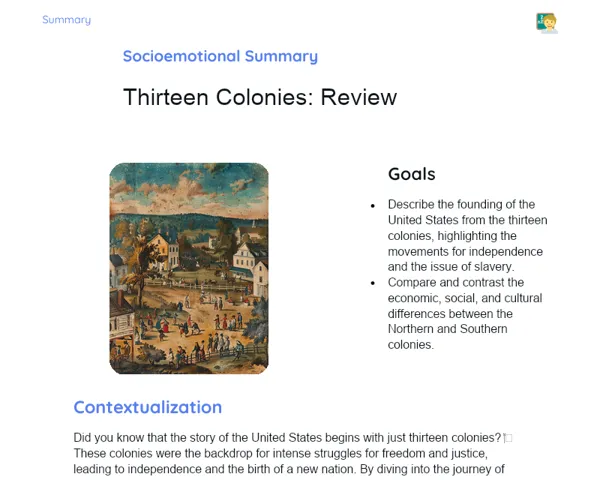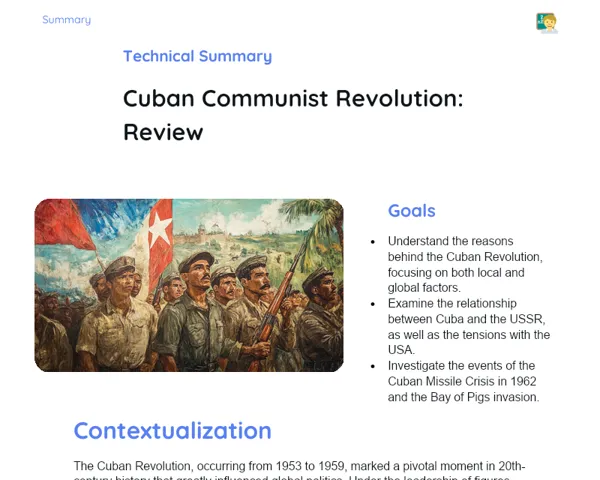Goals
1. Investigate how the United States took shape through the establishment of the thirteen colonies.
2. Examine the dynamics between the colonists and Indigenous peoples during the colonial era.
3. Discuss the impacts of slavery and the economic divides between Northern and Southern colonies.
Contextualization
The thirteen colonies laid the groundwork for what we know today as the United States, a nation that would rise to be one of the world's foremost powers. This era shines a light on the complex identities, conflicts, and alliances that sculpted social and political relationships of the time. For instance, the Northern economy flourished with a focus on industry and trade, while the Southern colonies were tightly intertwined with agriculture and reliant on slave labour. These regional disparities still echo in America's economy and society. Having a grasp of this backstory is vital for understanding the development of modern societies and their governing structures.
Subject Relevance
To Remember!
Formation of the Thirteen Colonies
The establishment of the thirteen colonies was an intricate process that saw British colonisation in North America from the 17th to the 18th centuries. Different groups, driven by various motivations like the search for religious freedom, economic opportunities, and land expansion, founded these colonies. Each colony developed unique traits, yet together they contributed to the emergence of what would later be the United States.
-
The thirteen colonies included: Massachusetts, New Hampshire, Rhode Island, Connecticut, New York, New Jersey, Pennsylvania, Delaware, Maryland, Virginia, North Carolina, South Carolina, and Georgia.
-
Every colony maintained its own governance and economic system, reflecting the origins and aspirations of its settlers.
-
Cultural and religious diversity was a hallmark of the colonies, shaping the future multicultural landscape of the United States.
Relationship of Colonists with Indigenous Peoples
The interactions between the colonists and Indigenous peoples were a tapestry of cooperation and conflict. Initially characterised by trade and alliances, as the colonists expanded, clashes became more frequent. These intricate relationships played a significant role in shaping the colonies and left a lasting impact on U.S. history.
-
At the outset, colonists depended on Indigenous peoples for their survival, receiving invaluable assistance and learning vital farming techniques.
-
Conflicts like King Philip's War and the Pequot War resulted in catastrophic losses for Indigenous peoples, who were systematically pushed off their land.
-
Certain Indigenous groups formed strategic alliances with colonists to gain leverage against rival tribes or common adversaries.
Slavery in the Colonies
Slavery was a cornerstone of the economy in the Southern colonies, where plantation owners heavily relied on enslaved labour for crops like tobacco, rice, and cotton. While slavery also existed in the North, it was less prevalent and typically involved domestic work and artisanship. The repercussions of slavery echoed socially, economically, and politically through American society for generations.
-
The transatlantic slave trade forcibly transported millions of Africans to the American colonies, where they endured horrific conditions.
-
Southern slavery was governed by harsh laws that stripped enslaved individuals of rights and freedom.
-
Abolitionist sentiments began to surface in the North in the 18th century, laying the groundwork for future confrontations over the issue of slavery.
Socioeconomic Differences Between the North and South
Distinct economies and societies emerged in the Northern and Southern colonies due to geography, climate, and cultural influences. The North leaned towards industrialisation and commerce, while the South remained agrarian and reliant on slavery, resulting in large plantations and a rigid social hierarchy.
-
The North thrived with shipbuilding and maritime trade, while the South focused on exporting agricultural products like tobacco and cotton.
-
These economic disparities gave rise to differing social and political organisations, with the North cultivating a robust middle class and the South being dominated by a small circle of affluent landowners.
-
Such contrasts stoked regional tensions that would eventually contribute to the American Civil War in the 19th century.
Practical Applications
-
Website case studies on regional economies in the U.S. can clarify how present-day economic inequalities have roots in North-South differences.
-
Discussions around reparations and civil rights can be informed by the historical backdrop of slavery and racial relations within the thirteen colonies.
-
Heritage preservation projects and archaeological work at colonial sites can shed light on everyday life, cultural customs, and interactions between colonists and Indigenous peoples.
Key Terms
-
Thirteen Colonies: The thirteen British colonies in North America that came together to form the United States.
-
Slavery: A system where individuals are compelled to work for others, devoid of rights and freedoms.
-
Indigenous Peoples: The native populations of North America who inhabited the region prior to European colonisation.
-
North-South Differences: The economic, social, and cultural variances between the northern and southern colonies that influenced U.S. history.
Questions for Reflections
-
In what ways do the economic and social chasms between the North and South still resonate in U.S. society and politics today?
-
What were the significant repercussions of the conflicts that occurred between colonists and Indigenous peoples for both groups?
-
How did the institution of slavery in the southern colonies impact the economic and social landscape of the United States?
Analysis of a Historical Document
To consolidate your understanding of the thirteen colonies and their internal dynamics, you will analyse a historical document from the period. This challenge will help you strengthen your research and critical analysis skills, essential for understanding the historical context and its significance.
Instructions
-
Select a relevant historical document (such as a letter, treaty, or narrative from a colonist or Indigenous person) connected to the thirteen colonies.
-
Thoroughly read the document, pinpointing the main themes and historical contexts outlined.
-
Respond to the following questions: What is the historical context of the document? What key themes are presented? How does the document illustrate the relationships between colonists and Indigenous peoples, or the economic interactions between the North and South?
-
Compose a one-page summary addressing your findings and analyses, and prepare to present your insights to the class.


